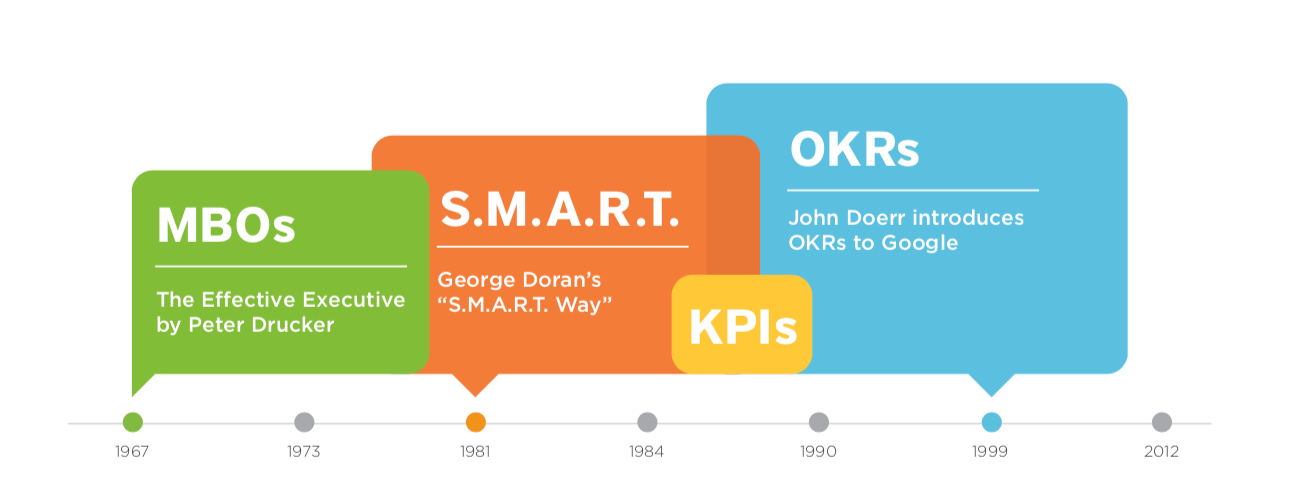Goals—Can't live with them; Can't live without them. Goals are necessary to motivate us and keep us moving forward. As human beings, we all feel a sense of achievement when a goal is met. For companies, goals provide much-needed direction and clarity.
However, the topic of goal management has always been a perplexing and intricate subject.
In today's article, we will take a brief journey through the origins of the four most widely used goal management techniques and explore the unique advantages that each approach offers.
Read more: Add values to business objectives with business process
Overview

The importance of goal management
Goal setting is the process of developing an action plan complete with individual or team targets to measure performance.
In short, goals help you to:
- Stay focused as it can be confusing to operate without knowing the purpose.
- Measure and track your progress.
- Motivate you to push forward.
- Determine where you want to be in the future.
Read more: Performance review – Which method is right for your enterprise?
4 commonly used goal management approaches
There are more than a handful of goal-setting approaches available; each has its own pros and cons and is suitable for a specific company culture. Today, we will only look at four of the most common techniques: MBO, SMART, KPI, and OKR.

Management by Objectives (MBO)
Management by Objectives (MBO), or management by results, was invented fairly early. Peter Drucker popularised the model in his 1954 book "The Practice of Management."
Midway through the 1960s, Drucker's students continued to develop the technique. Many companies, particularly Hewlett-Packard, favoured this goal-management system.
MBO requires the management and employees to define and agree on specific companies' objectives and then decide what actions to take to achieve each goal in sequence.
MBO allows managers and employees to work with a calm demeanour by taking actions one step at a time. Measuring the employee's actual performance against the set objectives is an essential part of MBO.
MBO sets a common ground for managers and their subordinates, allows them to define each individual's areas of responsibility, and tracks their performance along the way, all with the purpose of achieving a mutual goal.
On the flip side, MBOs can become counterproductive if not appropriately managed. For example, employees bypass the quality aspect to achieve the set objectives.
SMART
SMART is an acronym for five elements: Specific, Measurable, Achievable (or Attainable), Realistic, and Timeliness. The term "SMART goals" was first popularised by George Doran in a Management Review issue in 1981.
This goal-setting method aims at defining goals in detail to achieve better results and minimise confusion.
Over the years, each element of SMART would get a different variation, depending on the author. Some would use Assignable or Agreed Upon instead of Achievable or Attainable, Results-focused instead of Realistic, and Trackable instead of Timeliness.
Some sources argue that the original inventor of SMART goals was Paul Myer; the concept was used in his 1965 work "Personal Success Planner."
Despite the controversies, SMART continues to be a popular goal-setting technique among marketers and project managers.
Those who do not favour this method perceive that it is too rigid, preventing users from innovating and achieving higher mountains.
Read more: Development – This is not an event. It’s a journey
Those who use SMART believe that attaching values to the elements ensures you have the basic definition for goal-setting right.
- The goal needs to target one area for improvement to be specific.
- Teams and individuals need to suggest some indicators to measure progress to be measurable
- The goal should not be entirely out of this world but should also not be too easy to be achievable.
- The goal should consider the current resources companies have on hand to be realistic.
- Finally, to create a sense of urgency, the goal should be time-limited.
Key Performance Indicators (KPIs)
Key Performance Indicators (KPIs) are undeniably one of the most commonly used goal management systems. Every professional knows what KPI is and how to apply it.
The exact date when KPIs were invented and the original inventor was unknown, but the practice of evaluating performance dates back to the third century.
In short, KPIs show how successful a business is or how productive an employee is through a set of quantifiable values, which are then compared against strategic goals. One needs to be fully aware of what is important to the business for KPIs to prove their usefulness.
Too often, businesses blindly apply industry metrics without considering their situation, which results in very little to no apparent improvement.
Many often forget that KPI is a form of communication. As such, KPI needs to be concise, clear, and transparent. One of the biggest cons of implementing KPIs in organisations is that employees can postpone (or even avoid) doing tasks that are not measured by a KPI.
Read more: How to build a KPI template
Objectives and Key Results (OKRs)
Objectives and Key Results (OKRs) are the new kid on the block. Though recently developed, OKRs quickly rose to fame thanks to an endorsement from Google.
Originally, OKRs were developed by Andy Gove, who introduced the concept to Intel during his time at the company. The concept was then carried over to Google by John Doerr in 1999. The company continues to use the method today.
Besides Google, Spotify, Twitter, LinkedIn, Airbnb, and even Target and ING Bank are businesses that adopt the OKR goal-setting technique.
By default, there are two components to OKRs:
- Objective: a detailed description of what companies want to achieve.
- Key Results: quantifiable values to measure progress.
While MBOs, KPIs, and SMART methods focus on being realistic and evaluating the currently available resources, OKRs, on the other hand, can be over-the-top.
It is common to see unmet objectives when using OKR. The method pushes teams and individuals to think outside the box and be ambitious.
OKRs are also more agile, as the timeline set using this approach tends to be shorter, allowing team members to adapt according to specific situations.
OKRs are driven from the bottom up, and each department's objectives must align with the company's overall objectives. Everyone is well aware of how their contributions can impact the overall business performance; as such, implementing OKR can increase transparency.
What's worth noting is that OKRs are not a checklist for every task you need to do. Instead, OKRs help companies determine the top priorities that need immediate attention today.
One common mistake businesses often make when defining OKRs for the first time is setting too many objectives and key results. Others treat OKRs as "new year resolutions," where they set objectives and key results but fail to follow them through.
Overall, the four goal-setting methods mentioned above agree on setting clear goals, implementing measurable metrics, and promoting transparency across all company levels. What differs is how each company defines its goals and objectives.
While there is no clear winner as to which method is the most superior, nothing beats a well-structured goal definition. Some find it helpful to combine several goal statements into a broader outcome area when their goals become too task-oriented and numerous.
Thus, to reach the highest mountains, TRG suggests you define your goals (the clearer, the better), align your goals with others as well as with the company's goals, and request everyone in your team to regularly update you on the progress.
Looking to optimise your talent management process? Don't hesitate to reach out to our team of talent experts by simply clicking the button below. We're here to address all your concerns and help you streamline your talent management for maximum efficiency and success.
 English
English  Vietnamese
Vietnamese 

